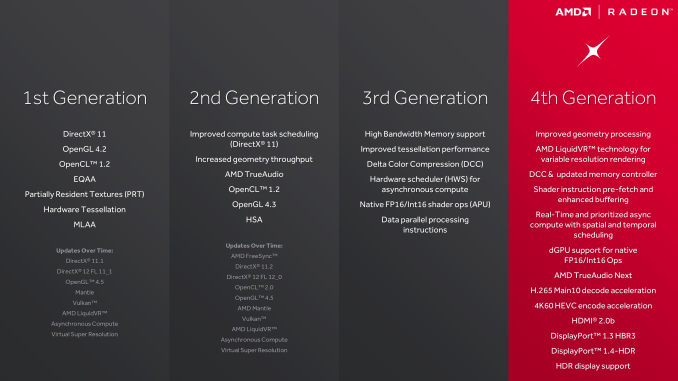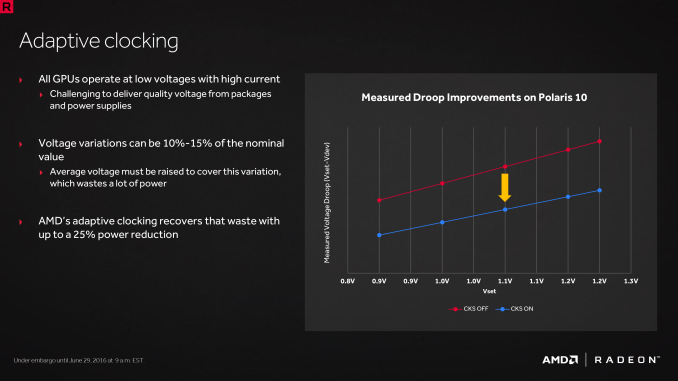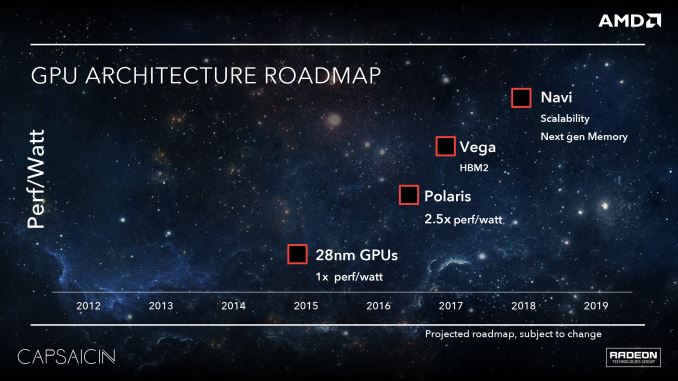The AMD Radeon RX 480 Preview: Polaris Makes Its Mainstream Mark
by Ryan Smith on June 29, 2016 9:00 AM ESTAMD's Path to Polaris
With the benefit of hindsight, I think in reflection that the 28nm generation started out better for AMD than it ended. The first Graphics Core Next card, Radeon HD 7970, had the advantage of launching more than a quarter before NVIDIA’s competing Kepler cards. And while AMD trailed in power efficiency from the start, at least for a time there they could compete for the top spot in the market with products such as the Radeon HD 7970 GHz Edition, before NVIDIA rolled out their largest Kepler GPUs.
However I think where things really went off of the rails for AMD was mid-cycle, in 2014, when NVIDIA unveiled the Maxwell architecture. Kepler was good, but Maxwell was great; NVIDIA further improved their architectural and energy efficiency (at times immensely so), and this put AMD on the back foot for the rest of the generation. AMD had performant parts from the bottom R7 360 right up to the top Fury X, but they were never in a position to catch Maxwell’s efficiency, a quality that proved to resonate with both reviewers and gamers.
The lessons of the 28nm generation were not lost on AMD. Graphics Core Next was a solid architecture and opened the door to AMD in a number of ways, but the Radeon brand does not exist in a vacuum, and it needs to compete with the more successful NVIDIA. At the same time AMD is nothing if not scrappy, and they can surprise us when we least expect it. But sometimes the only way to learn is the hard way, and for AMD I think the latter half of the 28nm generation was for the Radeon Technologies Group learning the hard way.
So what lessons did AMD learn for Polaris? First and foremost, power efficiency matters. It matters quite a lot in fact. Every vendor – be it AMD, Intel, or NVIDIA – will play up their strongest attributes. But power efficiency caught on with consumers, more so than any other “feature” in the 28nm generation. Though its importance in the desktop market is forum argument fodder to this day, power efficiency and overall performance are two sides of the same coin. There are practical limits for how much power can be dissipated in different card form factors, so the greater the efficiency, the greater the performance at a specific form factor. This aspect is even more important in the notebook space, where GPUs are at the mercy of limited cooling and there is a hard ceiling on heat dissipation.
As a result a significant amount of the work that has gone into Polaris has been into improving power efficiency. To be blunt, AMD has to be able to better compete with NVIDIA here, but AMD’s position is more nuanced than simply beating NVIDIA. AMD largely missed the boat on notebooks in the last generation, and they don’t want to repeat their mistakes. At the same time, starting now with an energy efficient architecture means that when they scale up and scale out with bigger and faster chips, they have a solid base to work from, and ultimately, more chances to achieve better performance.
The other lesson AMD learned for Polaris is that market share matters. This is not an end-user problem – AMD’s market share doesn’t change the performance or value of their cards – but we can’t talk about what led to Polaris without addressing it. AMD’s share of the consumer GPU market is about as low as it ever has been; this translates not only into weaker sales, but it undermines AMD’s position as a whole. Consumers are more likely to buy what’s safe, and OEMs aren’t much different, never mind the psychological aspects of the bandwagon effect.
Consequently, with Polaris AMD made the decision to start with the mainstream market and then work up from there, a significant departure from the traditional top-down GPU rollouts. This means developing chips like Polaris 10 and 11 first, targeting mainstream desktops and laptops, and letting the larger enthusiast class GPUs follow. The potential payoff for AMD here is that this is the opposite of what NVIDIA has done, and that means AMD gets to go after the high volume mainstream market first while NVIDIA builds down. Should everything go according to plan, then this gives AMD the opportunity to grow out their market share, and ultimately shore up their business.
As we dive into Polaris, its abilities, and its performance, it’s these two lessons we’ll see crop up time and time again, as these were some of the guiding lessons in Polaris’s design. AMD has taken the lessons of the 28nm generation to heart and have crafted a plan to move forward with the FinFET generation, charting a different, and hopefully more successful path.
Though with this talk of energy efficiency and mainstream GPUs, let’s be clear here: this isn’t AMD’s small die strategy reborn. AMD has already announced their Vega architecture, which will follow up on the work done by Polaris. Though not explicitly stated by AMD, it has been strongly hinted at that these are the higher performance chips that in past generations we’d see AMD launch with first, offering performance features such as HBM2. AMD will have to live with the fact that for the near future they have no shot at the performance crown – and the halo effect that comes with it – but with any luck, it will put AMD in a better position to strike at the high-end market once Vega’s time does come.













449 Comments
View All Comments
Yojimbo - Wednesday, June 29, 2016 - link
Why? Who is going to switch from a GTX 980 to an RX 480 for performance in two DX12 games? I don't think those two DX12 titles can accurately be thought of as being fully representative of DX12 performance, especially since they seem to favor AMD cards to begin with, so it doesn't show the sort of categorical comparison you are implying.smackosaurus - Wednesday, June 29, 2016 - link
Well if there are more like me out there and have several family members each with their own PC.. cards have to last a couple of years AND be affordable for the average joe. Since DX 12 is replacing DX1 and every major title announced lately and probably every major title in the future will be Dx12.. the Value of the 480 sticks out. Especially since ever the flagship 1080 has to use software emulation for some DX12 features, because Nvidia decided to just plain leave it out of the hardware. Preemption=/=asyncYojimbo - Thursday, June 30, 2016 - link
I don't think it's certain that DX12 will completely replace DX11, even in major titles. But even if so, that does nothing to change the fact that the number of DX 12 titles available now to benchmark is quite small, resulting in a small sample size. With a small sample size one is not able to make the broad inferences you would like to make. The 980 is likely to be discontinued anyway shortly after the 1060 comes out, completely destroying any reason at all for having it in the charts.Maxwell does have hardware support for asynchronous compute. Pascal has an enhanced version of it. async != ACE. ACEs are task schedulers which are used in AMD's method of supporting asynchronous compute. I have a feeling that the idea that NVIDIA does asynchronous compute "in software" has to do with the fact that NVIDIA was working on driver optimizations to try to make the asynchronous compute implementation in Ashes of the Singularity show benefit on NVIDIA's hardware. I'm not sure if NVIDIA ever achieved that or if they've given up or what, but to my understanding NVIDIA was turning the feature off in their driver profile for Ashes of the Singularity because with Oxide's implementation and NVIDIA's method asynchronous compute actually caused the game to run more slowly than it did without it. Again, one game and one implementation is a small sample size. It doesn't tell you much on its own. Independent testing showed there were situations, even on Maxwell hardware, where NVIDIA's method produced a larger speed boost from asynchronous compute than AMD's method. Another thing to consider is that the speed boost that AMD gets in DX 12 with asynchronous compute has something to do with the fact that AMD tends to make less efficient use of their compute throughput than NVIDIA without asynchronous compute. Finally, considering that AotS was designed from the beginning as a Mantle game, it isn't just one data point, it's also perhaps not a very reliable one.
For more information on asynchronous compute in Pascal, perhaps this video will be informative:
https://www.youtube.com/watch?v=Bh7ECiXfMWQ
cocochanel - Thursday, June 30, 2016 - link
DX12 is the latest and the best graphics API Microsoft has ever made. All future games, be they for the PC or Xbox One will use it. How can anyone sell a card that performs poorly on it ? And sell it for 800+ dollars ?Yojimbo - Thursday, June 30, 2016 - link
The GTX 1080 does not perform poorly on DX12 games. What benchmarks have you been looking at?!cocochanel - Saturday, July 2, 2016 - link
http://www.pcworld.com/article/3071037/hardware/nv...crimson117 - Wednesday, June 29, 2016 - link
Typo: For the 480 4GB model, VRAM is listed as 8GB in the table on page 1,webdoctors - Wednesday, June 29, 2016 - link
I called it a month ago when the new cards starting coming out.The $200 market is really competitive and you're competing against not just the current cards but previous generations one level up. You're already seeing GTX970 cards at the same pricepoint after rebate in the USA as this "new" RX 480 card.
Will have to wait for the 1060 review, but it'll likely wipe this card out of the landscape since this one only matches Maxwell Perf/W and perf is only GTX970 levels...win for consumers but not so much for AMD.
maccorf - Wednesday, June 29, 2016 - link
Love comments like this...so a $330+ card with no currently known benchmarks will "likely wipe" a $240, well performing card "out of the landscape"? That is an entire jump in cost market, and you don't even know what the 1060 will do. "I called it..." LOL called what? This card being the new standard for performance and price? The only reason those GTX970 cards are coming down are because of the RX 480. People are so absurd with this, is it even possible for you trolls to ever admit you're completely and utterly biased?mdriftmeyer - Wednesday, June 29, 2016 - link
It's not possible for these grown children to act like adults.